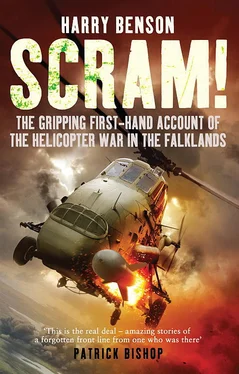Disoriented by the sudden whiteout and complete lack of visual references, Tidd glanced into the cockpit at his instrument panel. The radio altimeter (radalt) was now unwinding at an alarming rate. Realising that collision with the ground was inevitable, Tidd hauled in power with his left hand and flared the aircraft nose up with his right to cushion the impact. The tail and left wheel of the Wessex hit the snow at about thirty knots, sheering away the undercarriage and causing the aircraft to come crashing down on its left side. The aircraft slid onwards for fifty yards. The left side of the cockpit filled up with debris and snow as the windows imploded. Had a co-pilot been sitting in the left seat, he would undoubtedly have been killed, crushed between the missile sight and the ice below.
As the helicopter ground to a halt, the inertia crash switches in the aircraft’s nose automatically shut down both engines. Tidd still had no real idea whether or not they would survive. Lying on his side, he reached down to turn off the fuel cocks and electrics to find the central panel and entire left side of the cockpit submerged under snow and broken glass. The only sounds were the howling wind outside and the cockpit windscreen wiper squeaking vainly up and down. Through the relative silence, Wilson’s distant voice shouted up from the back: ‘Everyone seems to be in one piece.’ Tidd slid open the flimsy cockpit window, now unfamiliarly above him, and clambered up onto the side of the aircraft to help Wilson open the rear cabin door.
From their position on the ice further up the glacier, Ian Stanley and Stewart Cooper had watched helplessly as the Wessex helicopter disappeared into the front edge of the snow storm ahead before banking left and sinking into a dip just before the ridgeline. Stanley’s only words were ‘Oh shit!’ as he saw Yankee Foxtrot’s rotor blades plough into the snow and the aircraft then crash and slide along on its side.
The snow shower passed as suddenly as it had appeared. Visibility improved once more. ‘Yankee Alpha, I’m going to hover-taxi up to them. Follow me and take care,’ radioed Stanley to Ian Georgeson as he lifted gently away from the ice and taxied the few hundred yards down the glacier. There was now no shortage of visual cues. Bits of Wessex tail rotor and other assorted debris lay dotted on the snow.
As the helicopters landed either side of the stricken Wessex, Georgeson’s aircrewman Jan Lomas jumped out and headed off to inspect the damage. Wilson and the SAS troops clambered up out of the wreck. Miraculously it appeared that nobody had been killed. The only injury was to one SAS staff sergeant who had been cut above his eye by the cabin machine gun.
Dazed, Tidd wandered over to the Wessex 3. Stanley’s crewman Fitz Fitzgerald plugged Tidd’s helmet into the cabin intercom. ‘God you’re a messy bastard,’ said Stanley from the cockpit above. ‘You’ve left the windscreen wiper on.’ It was the words of an experienced leader easing the pressure from the situation.
‘If you can find the fucking switch, you go and turn it off,’ replied Tidd with feeling.
Out on the snow, the two crewmen Fitzgerald and Lomas divided the soldiers between the two remaining helicopters. The SAS troops were not at all happy about having to leave their kit behind and keep only their side-arms. But they were given no choice. The helicopters were already at maximum weight and could lift no more. While Georgeson jettisoned fuel directly onto the glacier to reduce weight further, Tidd and two troops squashed into the back of Stanley’s Wessex 3. Wilson and the remaining four troops went with Georgeson’s Wessex 5. With ten people now crammed into the Wessex 3 and fourteen people in the Wessex 5, Stanley radioed Georgeson to ‘follow me’. The depleted formation rose to the hover once again.

The shocking scene on Fortuna Glacier just after Mike Tidd’s Wessex 5 crashed on its side. The engine is still smoking. Ian Georgeson’s helicopter is in the background. This photo was taken from the cockpit of HMS Antrim’s Wessex 3. The SAS men inside this helicopter were split between the two surviving helicopters. Georgeson’s Wessex crashed ten minutes later as he crossed the glacier’s ridgeline in whiteout conditions.
In the back of the Wessex 3, Stanley’s observer Lieutenant Chris Parry sat crouched over the radar screen. His job was to keep the formation clear of the cliffs to the side of the glacier. What he couldn’t see was the ice ridge in front of him; the forward sweep of the radar was blocked by the helicopter’s main gearbox just in front of the radar dome. As Stanley crossed the ridge, Georgeson was following a few rotor lengths behind in Yankee Alpha. Another ferocious snowstorm hit the formation just at the wrong moment, barely ten seconds after launch. As the Wessex 3 dropped rapidly down over the ridgeline, automatically maintaining a low altitude over the steeply descending glacier, Georgeson lost sight of the aircraft in front. ‘I’m getting whiteout,’ he announced calmly to his crewman Lomas, who reopened the cabin door that he had only just shut. Trying to maintain level flight in order to regain visual contact with the aircraft in front, Georgeson was completely unaware that he was in a dip in the ice and on the wrong side of the ridgeline. Just as with Tidd minutes earlier, he saw the radalt unwinding rapidly and pulled in power. There was a fateful inevitability as the Wessex touched down on the snow.
They almost got away with it. However, the forty-knot wind slewed them around so that they were drifting slowly sideways. The starboard wheel caught in a small ice crevasse and the aircraft toppled over onto its side.
In the lead aircraft, Cooper had been peering behind him through the left cockpit window giving his crew a running commentary on the position of the second Wessex. ‘OK, OK. Fine. He’s still with us. Fifty yards. Steady. Oh God. He’s gone in.’ The huge spray of snow and the complete disappearance of the Wessex suggested a huge crash into the cliffs. ‘It looks like they have really totalled themselves.’
With no radio contact, an overloaded helicopter and appalling weather conditions, there was nothing for it but to return to HMS Antrim , the County-class destroyer from which they had launched two hours earlier. The journey back was subdued. They cleared the mountains and crossed the coast. Parry radioed disconsolately ahead to the ship: ‘Four Zero Six departing coast now. ETA fifteen minutes. Regret we have lost our two chicks.’
There was a long pause.
‘Roger.’
After the horrific conditions high up on Fortuna Glacier, the normally taxing task of landing on a bucking ship in a mere gale now seemed curiously routine. The scrum of soldiers and crew tumbled out of the back of the Wessex 3 onto the flight deck. Tidd approached the hangar surprised to see Stanley’s senior maintainer, Chief Fritz Heritier, and his team laying out a load of drips and stretchers. ‘Guys, you don’t need that, our only injury is a gashed cheek.’ It was painfully obvious that Tidd, who had been disconnected from the intercom in the crush of the returning aircraft, didn’t know about the second crash.
When he heard, it was like a kick to the stomach. Ian Georgeson, Tug Wilson and Jan Lomas were good friends as well as colleagues. Tidd went up to the bridge to talk to Antrim ’s captain, Brian Young, task group commander. A former aviator himself, he knew what it was like to lose friends.
Up on the glacier, Yankee Alpha had toppled over on its right side with a sickening thud. After spraying its rotor blades to the four corners, it had juddered a few yards onwards down the glacier. The cabin of the aircraft was a tangle of bodies, backpacks and ammunition. Lomas lay at the bottom of the pile, pinned down by Wilson, in turn pinned down by one of the SAS soldiers. Looking sideways, Lomas could see Georgeson’s feet kicking to his right. ‘Are you alright, boss?’ shouted Lomas.
Читать дальше













